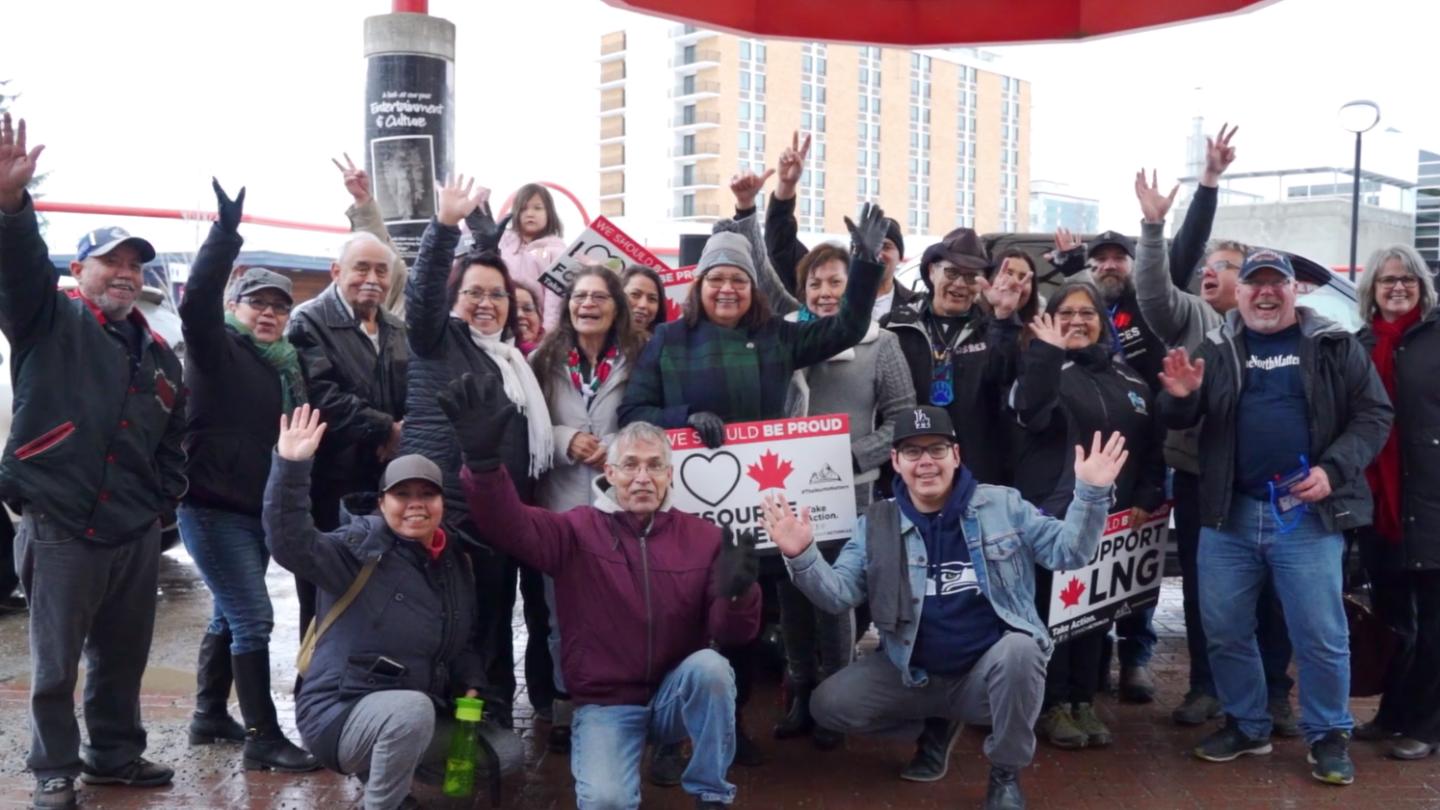A majority of First Nations in British Columbia and Alberta that have publicly declared their positions support oil and gas extraction and development, according to data analyzed by the Canadian Energy Centre.
The Fact Sheet (which can be downloaded here as a pdf) is the result of an in-depth survey of publicly available data and other sources to assess First Nations in Canada’s two westernmost provinces that are near to oil and gas development, or mostly likely to be impacted by oil and gas development, and their position on the activity.
Highlights from the Fact Sheet include:
- Of 202 B.C. First Nations, a minimum of 29 were found to favour oil and oil pipeline development with just three opposed, an almost ten-to-one ratio. Sixty-four First Nations were found to non-object or be unclear and 106 First Nations were ranked as not applicable.
- Forty B.C. First Nations were found to be in favour of natural gas development, with none found to be opposed, One hundred and sixty-one B.C. First Nations either had no public position or were not affected by natural gas projects.
- Out of 48 Alberta First Nations, 46 were found to be supportive of oil extraction and development including pipeline construction. None were opposed. Two First Nations were either unclear or information was not available or not applicable.
- Forty-six Alberta First Nations were in favour, none found to be opposed, and two First Nations either had no stated position or it was not available or unclear.
———————————————————————————
Quantifying actual First Nations’ positions on oil and gas development
Oil and natural gas are a substantial part of Canada’s resource economy, especially in Western Canada where, historically, the majority of activity has occurred. This extraction is also mostly a rural activity. That reality is matched by another one: The rural location of many First Nations reserves. This geographic “match up” of rural First Nations and Canada’s resource economy is not often recognized in urban Canada, where the narrative from anti-oil and gas activists and media stories on occasion portray First Nations in British Columbia and Alberta as broadly anti-oil and gas development.
In fact, many First Nations are involved in and benefit from oil and gas development. Two prominent examples are Fort McKay in Alberta, which has a long history with the oil sands industry, and the Haisla First Nation in British Columbia, which is embarking on new liquified natural gas (LNG) partnerships.
To better understand actual levels of support or opposition to oil and gas development, this Fact Sheet assesses the First Nations in British Columbia and Alberta that are near to oil and gas development or mostly likely to be impacted by oil and gas development, and their position on the activity.
B.C. and Alberta measurements
We quantify the support or opposition to oil and gas development (extraction, pipeline development or export terminals)¹ in both provinces among First Nations using stated positions, proxy measurements, and public actions and statements of their elected officials.
- ‘Yes’ indicates clear support in general for an oil or gas development or pipelines, or for a specific project.
- ‘No’ indicates clear opposition in general for an oil or gas development or pipelines, or to a specific project, and absent any conflicting signals, i.e., support for some other project.
- ‘Non-object/unclear’ indicates First Nations who in terms known in the industry either formally do not object to a project and/or have withdrawn a previous objection. This is not as strong as ‘Yes’ but it is also not a ‘No’ given some First Nations have withdrawn previous objections to a project, i.e., withdrawing opposition to the Trans Mountain pipeline.
- The “N/A” categorization is for First Nations who have not been formerly consulted on current oil or gas projects or who do not extract oil and gas. While some of these First Nations may offer an opinion in support of or object to specific projects, given the lack of a nearby project and/or involvement in an imminent decision relative to their First Nation, we are not assessing opinions as strong enough to offer a conclusion either way.²
In the case of N/A, we note the numbers but do not include them in the charts, given the peripheral nature of opinions on projects and pipelines that do not impact these First Nations. Expressed another way, if we were measuring support or opposition to a proposed sawmill on the shore of the Fraser River in Delta, B.C., we would not measure the support or opposition of a town council on the Prairies, given the lack of any impact by the former on the latter.
1. This is not an exhaustive list of Indigenous groups involved in oil and gas, and oil and gas infrastructure development, and thus does not include non-status and regional/local Metis. Also, support for oil and gas projects are often conditional and can vary from project to project, depending on perceptions and realities of Crown and proponent consultation, among other factors. We do not weigh in on such discussions here as they are beyond the scope of this review. 2. “Free, prior, and informed” consent is the standard under which consultation must be performed and the nations that have gone through the regulatory process have undoubtedly granted or have not granted “informed consent” given the extensive process. That is the standard of “informed” consent we can measure in this fact sheet.
British Columbia
While British Columbia is no stranger to oil and natural gas development there are few to no opportunities to produce oil and gas outside the Horn River, Cordova, and Montney regions, i.e., northern British Columbia. Thus, in our assessment of British Columbia First Nations, part of measurements included both oil pipeline and natural gas pipeline projects as a proxy for their support/objection to oil or gas more broadly.
Of note, a First Nations community with an Impact Benefit Agreement with an oil and gas developer does not necessarily mean that the entire community supports the project; however, it does show that elected leadership has undertaken a community process to understand whether the benefits generated by the project are satisfactorily substantial and that the impacts generated by the project are satisfactorily addressed and mitigated to allow the project to move forward in their territory.
- While fewer nations in BC (relative to Alberta) are members of the Indian Resource Council (IRC), whose mandate is “to support First Nations in their efforts to attain greater management and control of their oil and natural gas resources,” membership in this organization indicates “support” for both oil and gas development.
- Membership in the First Nations LNG Alliance indicates support for natural gas development.
- Possessing an impact benefit agreement on either the Trans Mountain Expansion Project or Coastal GasLink indicates support for either oil or gas, respectively.
- Support is indicated if the Nation was consulted on projects such as Steelhead LNG, Woodfibre LNG or Prince Rupert Gas Transmission and either signed impact benefit agreements or consented to the development of these projects in their traditional territories.
- Membership in the First Nations Major Project coalition, which has supported participation in oil and gas, amongst other large projects, would be a secondary indicator of a Nation’s support to both oil and gas development.
Alberta
Alberta First Nations have a 60-plus year history of working with the oil and gas industry, with decisions made within each First Nations on a project by project basis. Alberta First Nations also have many band-owned companies that participate and provide numerous energy and energy infrastructure ancillary services. The result is that there are several Indigenous-led, private and Crown organizations that advocate and manage First Nations oil and gas resources and related business activity that we take as a strong indicator of support of oil and gas by community. Thus, our measurements for Alberta include:
- Membership in the Indian Resource Council (IRC).
- Being a stakeholder as identified by Indian Oil and Gas Canada (IOGC), which manages and regulates oil and gas resources on First Nation reserve lands. IOGC publishes quarterly the “Top 10 Oil” and “Top 10 Gas” producing First Nations in Canada. if the Nation falls on either list, then a “support” designation would result.
- Possessing a Trans Mountain Expansion Project Impact Benefit Agreement would be a strong indicator of “support” for oil projects.
- In several cases, research on specific First Nations in Alberta has resulted in “yes” or “unclear” determinations.
Results for British Columbia First Nations: Ten-to-one in favour of oil, no recorded opposition to natural gas
Oil: Of 202 B.C. First Nations, a minimum of 29 were found to favour oil and oil pipeline development with just three opposed, an almost ten-to-one ratio. Sixty-four First Nations were found to non-object or be unclear and 106 First Nations were ranked as N/A (see Figure 1).³
Natural gas: 40 First Nations were found to be in favour of natural gas development, with none found to be opposed, and one unclear (the Binche Whut’en is Canada’s newest First Nation and does not have a clear record given the short history since its independence from Tl’azt’en Nation April 2019). One hundred and sixty-one First Nations either had no public position or were not affected by natural gas projects. (see Figure 2)
3. Of note, a majority of the approximately 100 B.C. First Nations that have been consulted on the Trans Mountain Expansion Project are categorized “non-object/unclear” as many Nations have not publicly disclosed whether or not they have an Impact Benefit Agreement and many have reserved their position on this project as confidential.
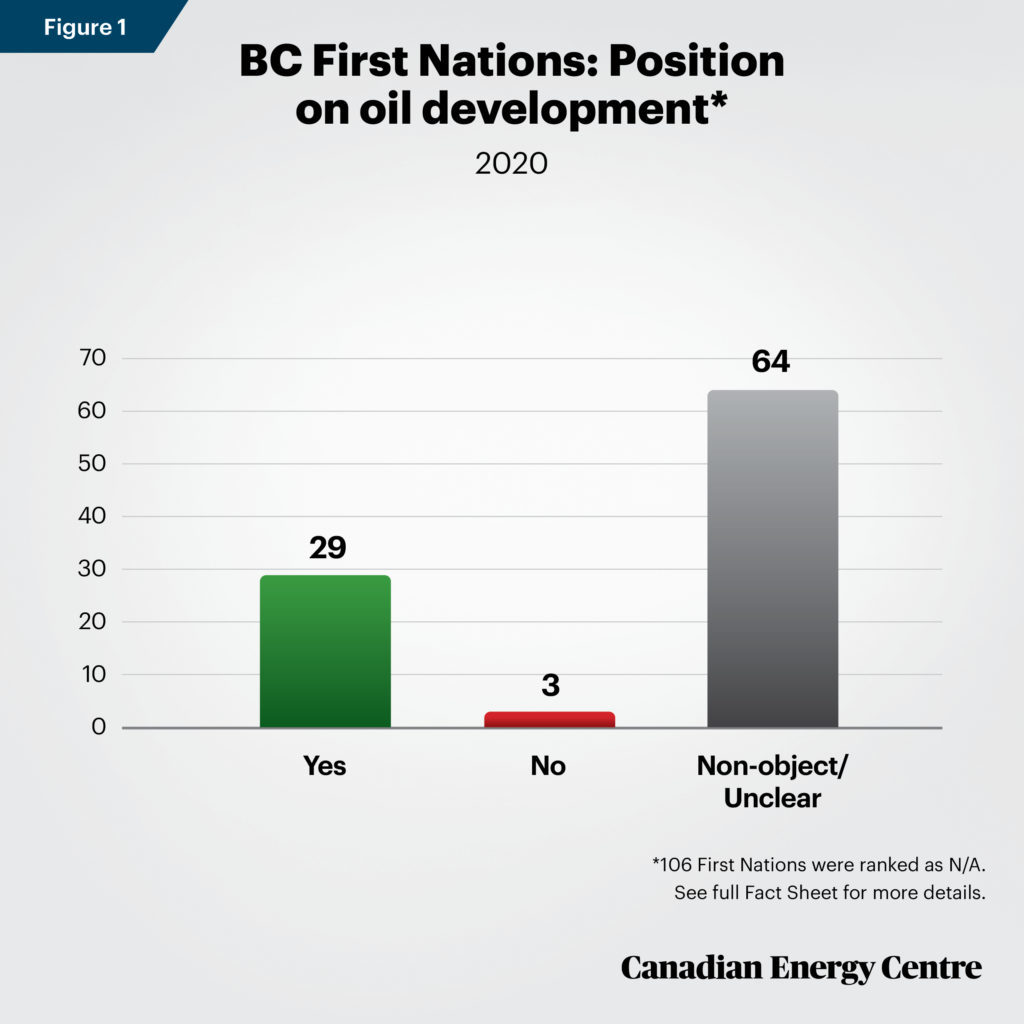
*106 First Nations were ranked as N/A. Sources: Canadian Energy Regulator, British Columbia Oil and Gas Commission, Coastal Gaslink, Trans Mountain, Indian Resource Council, First Nations Major Project Coalition, First Nations LNG Alliance, Indian Oil and Gas Corporation, Individual First Nations’ Community Websites, and personal correspondence.
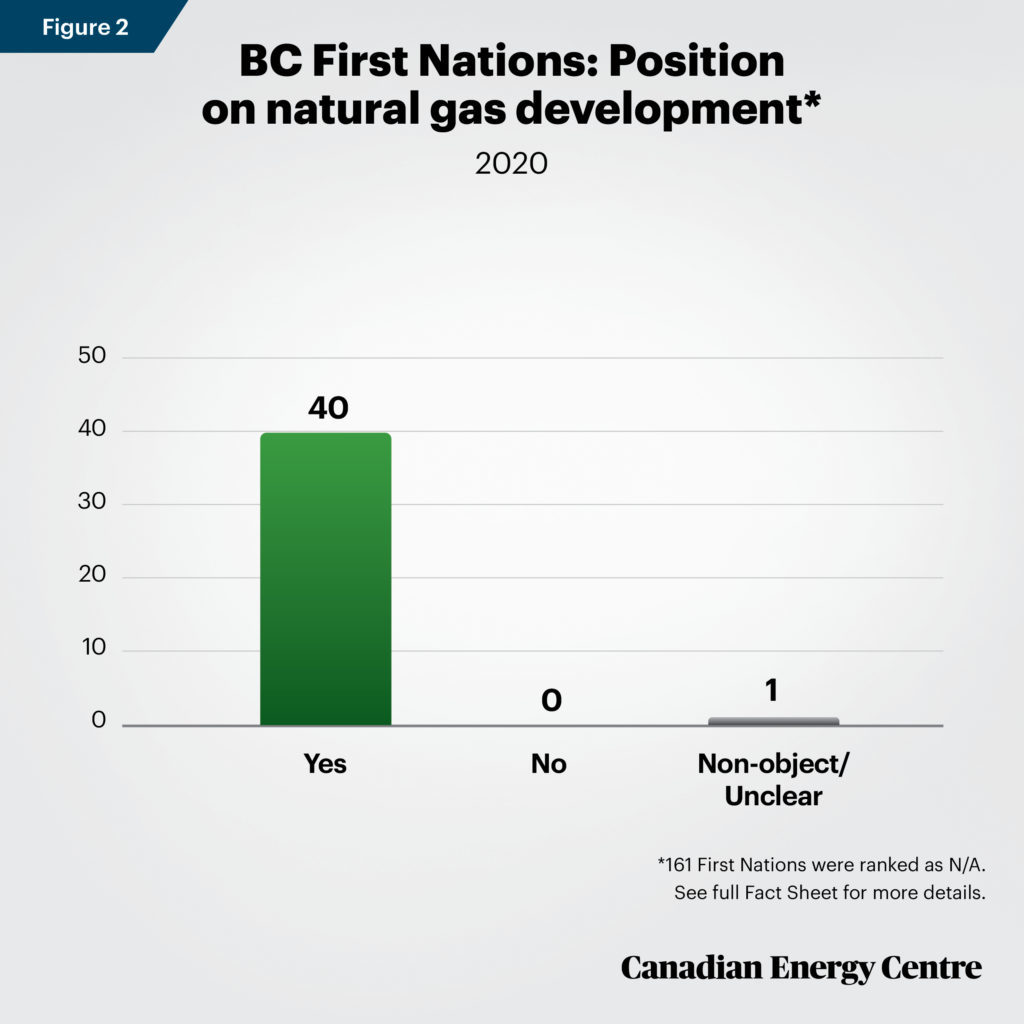
*161 First Nations were ranked as N/A. Sources: Canadian Energy Regulator, British Columbia Oil and Gas Commission, Coastal Gaslink, Trans Mountain, Indian Resource Council, First Nations Major Project Coalition, First Nations LNG Alliance, Indian Oil and Gas Corporation, Individual First Nations’ Community Websites, and personal correspondence.
Results for Alberta First Nations: 46 in favour of oil and natural gas, no recorded opposition to either
Oil: Out of 48 Alberta First Nations, 46 were found to be supportive of oil extraction and development including pipeline construction. None were opposed. Two First Nations were either unclear or information was not available or not applicable (Figure 1).
Natural gas: For natural gas development, 46 First Nations were in favour, none found to be opposed, and two First Nations either had no stated position or it was not available or unclear.
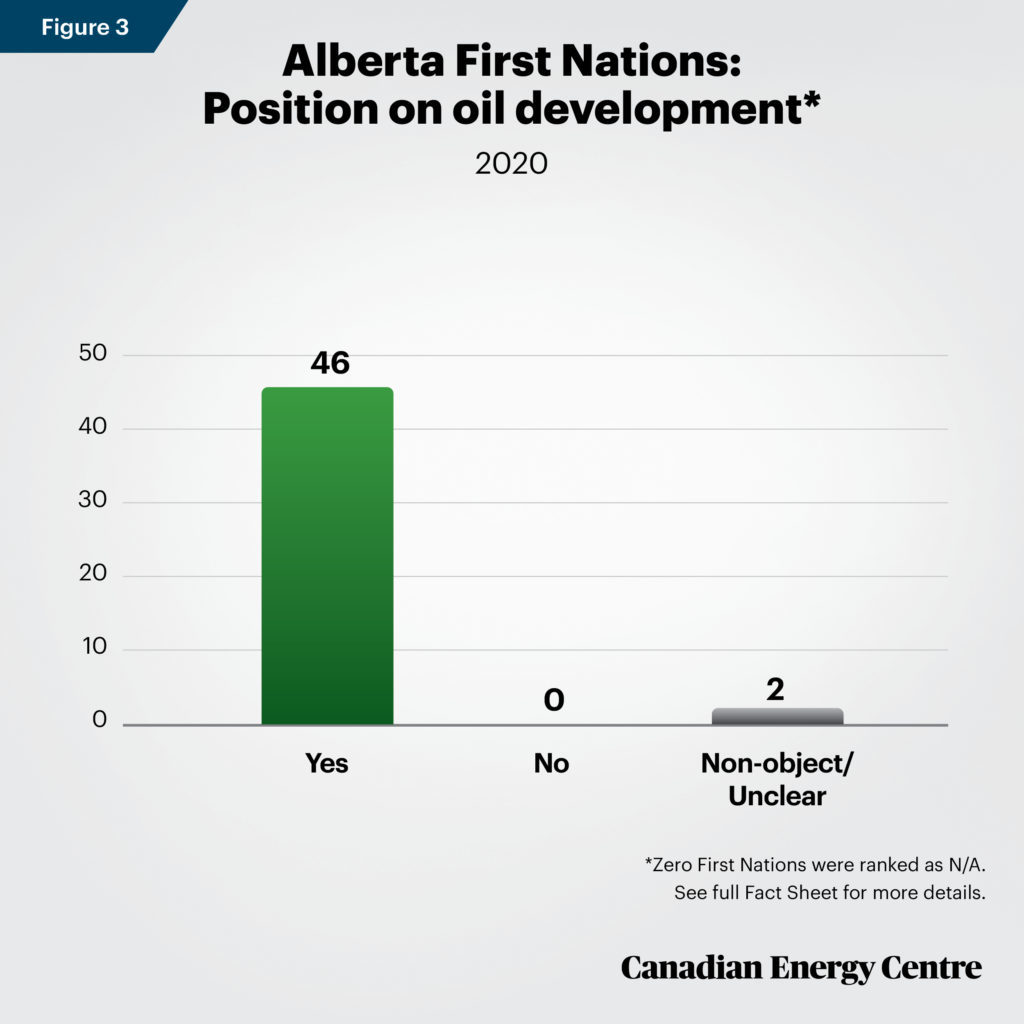
*Zero First Nations were ranked as N/A. Sources: Canadian Energy Regulator, British Columbia Oil and Gas Commission, Coastal Gaslink, Trans Mountain, Indian Resource Council, First Nations Major Project Coalition, First Nations LNG Alliance, Indian Oil and Gas Corporation, Individual First Nations’ Community Websites, and personal correspondence.
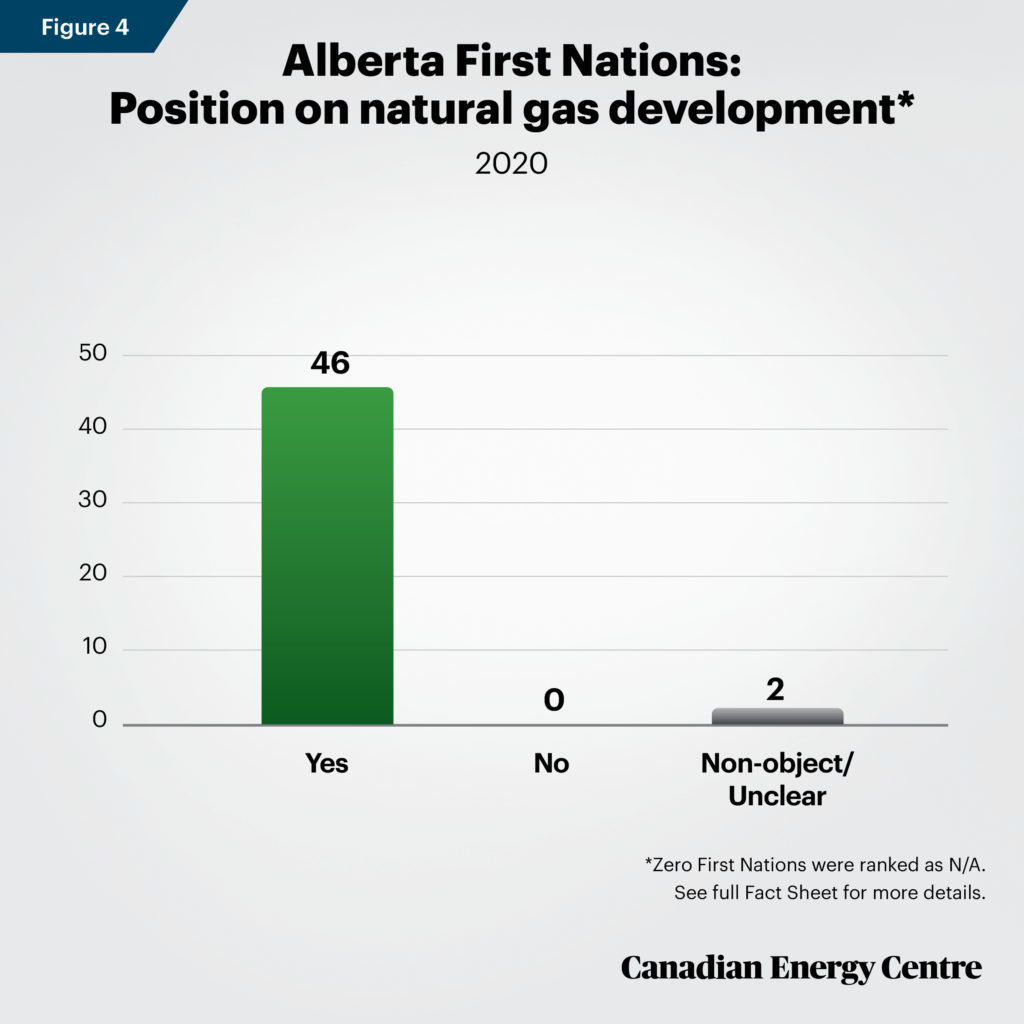
*Zero First Nations were ranked as N/A. Sources: Canadian Energy Regulator, British Columbia Oil and Gas Commission, Coastal Gaslink, Trans Mountain, Indian Resource Council, First Nations Major Project Coalition, First Nations LNG Alliance, Indian Oil and Gas Corporation, Individual First Nations’ Community Websites, and personal correspondence.
Why it matters: employment and incomes
Oil and natural gas extraction and related activities matter to First Nations in part because of employment and income opportunities, as discussed in our recent Fact Sheet.
According to the 2016 Census, for Indigenous Canadians, as for other Canadians, the oil and gas sector pays well. For example, the median employment incomes (full-time, fullyear) for self-identified Indigenous Canadians in construction ($49,262), pipelines ($117,831), or oil and gas extraction ($142,833) are all higher than the all-industry average ($44,855).
Moreover, when compared with an all-industry employment representation average of five per cent, indigenous participation in oil and gas extraction is 8.6 per cent of the workforce (British Columbia statistics). In short, the greater the participation of First Nations in oil and gas activities the greater the employment and incomes for Indigenous British Columbians and Albertans. This may explain why a large number of First Nations record public support for oil and natural gas activities.
The takeaway
The available data compiled shows that support for oil and natural gas extraction and development in British Columbia and Alberta is supported by the vast majority of First Nations that have a publicly available position: 29 of 32 in the case of First Nations in B.C. for oil and 40 of 40 in the case of natural gas; 46 of 46 in the case of First Nations in Alberta for oil and 46 of 46 publicly available positions in the case of natural gas. Very few First Nations oppose resource development on principle, reflecting the importance of these industries as a source of local job opportunities and incomes in remote areas.
Notes:
This CEC Fact Sheet was compiled by Gregory John and Mark Milke at the Canadian Energy Centre: www.canadianenergycentre.ca. The authors and the Canadian Energy Centre would like to thank and acknowledge the assistance of Philip Cross in reviewing the data and research for this Fact Sheet. Image credit: StockstudioX
Sources: (Links live as of June 30, 2020)
Alberta Native News (2019). “IRC and FNMPC Sign An Agreement to Unite Their Interests”<https://bit.ly/2CgbSKZ>; British Columbia Oil and Gas Commission (2020), “Archived – Prince Rupert Gas Transmission” <https://bit.ly/2AOvK7J>; British Columbia Oil and Gas Commission (2020). Woodfibre LNG Regulatory Documents <https://bit.ly/3hEaNwN>; Canadian Energy Regulator (formerly National Energy Board). “Trans Mountain Pipeline ULC – Trans Mountain Expansion Project”, <https://bit.ly/2Nnfn4V>; Canadian Energy Regulator (formerly National Energy Board) (2019), “Trans Mountain Pipeline ULC – Application for the Trans Mountain Expansion Project,” Reconsideration Hearings, <https://bit.ly/37EHrtK>; Coastal GasLink (2020),“Agreements in place with all 20 elected First Nations along the route,” <https://bit.ly/2Nne3Pv>; First Nations LNG Alliance (2020), “FNLNGA – Board Members” <https://bit.ly/2YRf8UX>; First Nations LNG Alliance (2020). “FNLNGA – Nations Supporting LNG Development,” <https://bit.ly/2UVKett>; Indian Resource Council (2020). “About – Indian Resource Council” <https://bit.ly/2UWAOxO>; Indian Resource Council (2020). “Membership – Indian Resource Council” <https://bit.ly/2Yf859o>; First Nations Major Projects Coalition (2020). “First Nations Major Projects Coalition – Core documents,” <https://bit.ly/2YdjOoN>; Indian Oil and Gas (IOGC) (2019). IOGC Annual Report 2018-2019 <https://bit.ly/2Bo7auw>; Indian Oil and Gas (IOGC) (2020). “Top First Nations Oil and Gas Producers Q1 2020. provided to CEC through correspondence; Indigenous and Northern Affairs Canada (undated). About British Columbia First Nations. <https://bit.ly/3dpZ3uG>; Indigenous and Northern Affairs Canada (undated). First Nations in Alberta. <https://bit.ly/3hSDB4Y>; Jones, Jeffrey and Shawn McCarthy (2016). “First Nations groups unmoved on pipeline opposition.” Globe and Mail, <https://tgam.ca/3hDfmYl>; Kaplan, Lennie and Mark Milke (2020), Twenty BC First Nations and Pipeline Prosperity. <https://bit.ly/2BfxTcr>; Milke, Mark and Lennie Kaplan (2020). Canada’s Oil and Gas Industry. <https://bit.ly/3dd60io>; Owen, Brenna (2018). “Update on indigenous Consultation on TMX”, APTN News, <https://bit.ly/3hGeeTE>; Penner, Derrick (2018), “Squamish First Nation makes difficult decision to back Woodfibre LNG worth 1.1 billion in benefits”, Vancouver Sun, <https://bit.ly/3hFSgjD>; Statistics Canada (undated). Census 2016: Focus on Geography Series. < https://bit.ly/31xt2yq>; Steelhead LNG (2014). “Kwispaa LNG an opportunity for Huu-ay-aht First Nations”; <https://bit.ly/2UZegwh>; Suzuki, David (2017). “Indigenous people are fighting for us all.” <https://bit.ly/3eeXVeo>; Trans Mountain (2019). “Upper Nicola and Trans Mountain Reach Agreement,” <https://bit.ly/2BmnZWm>; Trans Mountain (2020). “Engagement” <https://bit.ly/2zOIAT6>.
Creative Commons Copyright
Research and data from the Canadian Energy Centre (CEC) is available for public usage under creative commons copyright terms with attribution to the CEC. Attribution and specific restrictions on usage including non-commercial use only and no changes to material should follow guidelines enunciated by Creative Commons here: Attribution-NonCommercial-NoDerivs CC BY-NC-ND.
